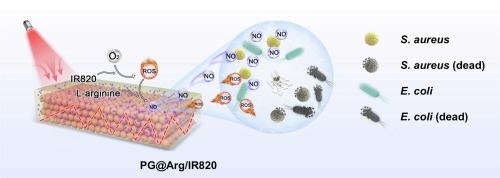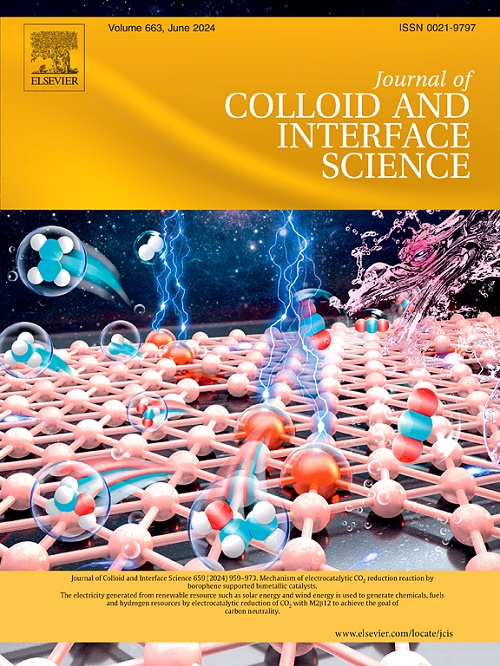光子水凝胶结合了慢光子效应和氮氧化物气体疗法,可协同增强光动力抗菌疗法。
IF 9.7
1区 化学
Q1 CHEMISTRY, PHYSICAL
引用次数: 0
摘要
光动力疗法(PDT)通过产生活性氧(ROS)提供了对抗细菌感染的潜力。然而,光敏剂的光子吸收有限,ROS的扩散长度和寿命较短,很大程度上阻碍了PDT的抗菌效率。本文提出了一种基于l-精氨酸修饰的新型吲哚菁绿光子水凝胶(PG@Arg/IR820)的光收集平台,用于协同慢光子效应和NO气体治疗,以提高PDT抗菌效率。在近红外(NIR)光照射下,PG@Arg/IR820可以通过慢光子效应最大限度地利用光子产生足够的ROS, ROS不仅是PDT中的主要杀菌剂,还可以触发l-精氨酸生成NO。NO具有较长的扩散距离和寿命,可以自由扩散以抑制远距离细菌生长,在ROS灭活细菌方面具有重要的互补优势。慢光子效应与NO气体疗法的协同作用使PG@Arg/IR820强化细菌破坏,提高PDT抗菌效率。这种抗菌系统阐明了光动力失活中有效抗菌活性的合理设计原则。本文章由计算机程序翻译,如有差异,请以英文原文为准。

Photonic hydrogels combining the slow photon effect and NO gas therapy for synergetic enhanced photodynamic antibacterial therapy
Photodynamic therapy (PDT) offers potential for combating bacterial infections through the generation of reactive oxygen species (ROS). However, the antibacterial efficiency of PDT is largely impeded by the limited photon absorption of photosensitizers and the short diffusion length and lifespan of ROS. Herein, we present a light-harvesting platform based on l-arginine-modified photonic hydrogels loaded with new indocyanine green (PG@Arg/IR820) for synergizing the slow photon effect with NO gas therapy to enhance PDT antibacterial efficiency. Upon near-infrared (NIR) light irradiation, PG@Arg/IR820 can maximize the utilization of photons via the slow photon effect to generate sufficient ROS, which not only acts as the primary bactericidal agent in PDT but also triggers l-arginine to generate NO. NO exhibits a long diffusion distance and lifespan and can freely diffuse to inhibit distant bacterial growth, demonstrating a vital complementary advantage in bacterial inactivation by ROS. The synergistic effect of the slow photon effect combined with NO gas therapy allows PG@Arg/IR820 to intensify bacterial destruction and enhance PDT antibacterial efficiency. This antibacterial system sheds light on an advisable design principle for efficient antibacterial activities in photodynamic inactivation.
求助全文
通过发布文献求助,成功后即可免费获取论文全文。
去求助
来源期刊
CiteScore
16.10
自引率
7.10%
发文量
2568
审稿时长
2 months
期刊介绍:
The Journal of Colloid and Interface Science publishes original research findings on the fundamental principles of colloid and interface science, as well as innovative applications in various fields. The criteria for publication include impact, quality, novelty, and originality.
Emphasis:
The journal emphasizes fundamental scientific innovation within the following categories:
A.Colloidal Materials and Nanomaterials
B.Soft Colloidal and Self-Assembly Systems
C.Adsorption, Catalysis, and Electrochemistry
D.Interfacial Processes, Capillarity, and Wetting
E.Biomaterials and Nanomedicine
F.Energy Conversion and Storage, and Environmental Technologies

 求助内容:
求助内容: 应助结果提醒方式:
应助结果提醒方式:


